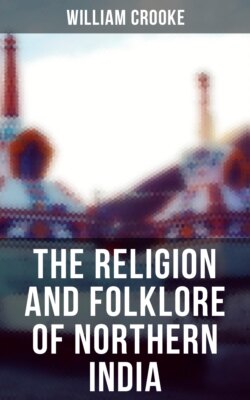Читать книгу The Religion and Folklore of Northern India - William Crooke - Страница 22
На сайте Литреса книга снята с продажи.
Earth-worship among the Drâvidians.
ОглавлениеTable of Contents
Among the Drâvidian races of Central India earth-worship prevails widely. In Chota Nâgpur the Orâons celebrate in spring the marriage of the earth. The Dryad of the Sâl tree (Shorea robusta), who controls the rain, is propitiated with a sacrifice of fowls. Flowers of the Sâl tree are taken to the village and carried round from house to house in a basket. The women wash the feet of the priest and do obeisance to him. He dances with them and puts some flowers upon them and upon the house. They first douse him with water as a means of bringing the rain, and then refresh him with beer.68
In Hoshangâbâd, when the sowing is over, its completion is celebrated by the Machandrî Pûjâ, or worship of Mother Earth, a ceremony intended to invoke fertility. “Every cultivator does the worship himself, with his family, servants, etc.; no Brâhman need join in it. At the edge of one of his fields intended for the spring harvest, he puts up a little semicircle or three-sided wall of clods about a foot high, meant to represent a hut. This is covered over with green Kâns grass (Imperata spontanea) to represent thatch. At the two ends of the hut two posts of Palâsa wood (Butea frondosa) are erected, with leaves round the head like those which are put up at marriage. They are tied to the thatch with red thread. In the centre of this little house, which is the temple of Machandrî, or Mother Earth, a little fire is made, and milk placed on it to boil in a tiny earthen pot. It is allowed to boil over as a sign of abundance. While this is going on, the ploughmen, who are all collected in a field, drive their bullocks at a trot, striking them wildly; it is the end of the year’s labour for the cattle. The cultivator meanwhile offers a little rice, molasses, and saffron to Machandrî, and then makes two tiny holes in the ground to represent granaries; he drops a few grains in and covers them over; this is a symbol of prayer, that his granary may be filled from the produce of the land.” Similar instances of symbolical magic will constantly occur in connection with similar rites. Then he puts a little saffron on the foreheads of the ploughman and the bullocks, and ties a red thread round the horns of the cattle. The animals are then let go, and the ploughmen run off at full speed across country, scattering wheat boiled whole as a sign of abundance. This concludes the rite, and every one returns home.69
Many similar usages prevail among the jungle tribes of South Mirzapur. The Korwas consider Dhartî Mâtâ one of their chief godlings. She lives in the village in the Deohâr or general village shrine under a Sâl tree. In the month of Aghan (November–December) she is worshipped with flowers and the offering of a goat. When she is duly worshipped the crops prosper and there are no epidemics. The Patâris and Majhwârs also recognize her as a goddess, and worship her in the month of Sâwan (August). The local devil priest or Baiga offers to her a goat, cock, and rich cakes (pûri). She is also worshipped in the cold weather before the grain and barley are sown, and again on the threshing-floor before the winnowing begins. The flesh of the animals is consumed by the males and unmarried girls; no grown-up girl or married woman is allowed to touch the flesh. The Ghasiyas also believe in Dhartî Mâtâ. She is their village goddess, and is presented with a ram or a goat or cakes. The offering is made by the Baiga, for whom the materials are provided by a general contribution in the village. The Kharwârs worship her at the village shrine before wood-cutting and ploughing begin. In the month of Sâwan (August) they do a special service in her honour, known as the Hariyârî Pûjâ, or “worship of greenery,” at the time of transplanting the rice. In Aghan (November) they do the Khar Pûjâ, when they begin cutting thatching-grass (khar). A cock, some Mahua (Bassia latifolia) and parched grain are offered to her. All this is done by the Baiga, who receives the offerings, and none but males are allowed to attend. Similarly the Pankas worship her before sowing and harvesting the grain. They and the Bhuiyârs offer a pig and some liquor at the more important agricultural seasons. The Kharwârs sometimes call her Devî Dâî, or “Nurse Devî,” and in times of trouble sprinkle rice and pulse in her name on the ground. When the crops are being sown they release a fowl as a scapegoat and pray—Hê Dhartî Mahtârî! Kusal mangala rakhiyo! Harwâh, bail, sab bachen rahen—“O Mother Earth! Keep in prosperity and protect the ploughmen and the oxen.” In much the same spirit is the prayer of the peasant in Karnâl to Mother Earth:—Sâh Bâdshâh sê surkhrû rakhiyê! Aur is men achchha nâj dê, to bâdshâh ko bhî paisa den, aur Sâh kâ bhi utar jâwê—“Keep our rulers and bankers contented! Grant us a plentiful yield! So shall we pay our revenue and satisfy our banker!”70
